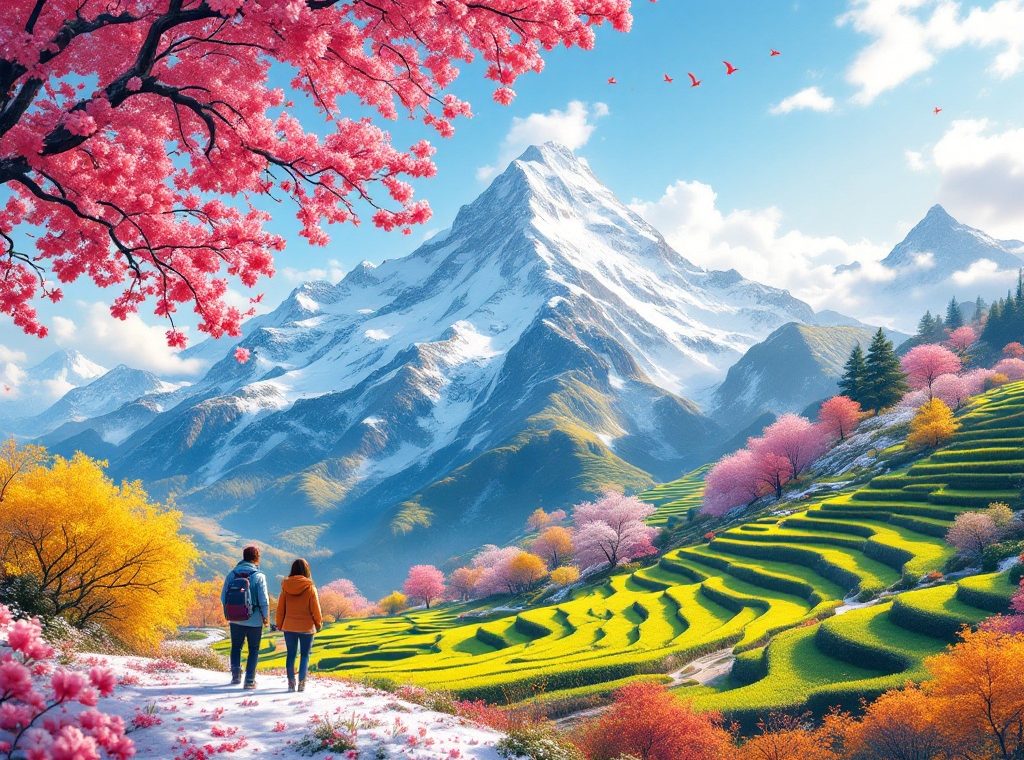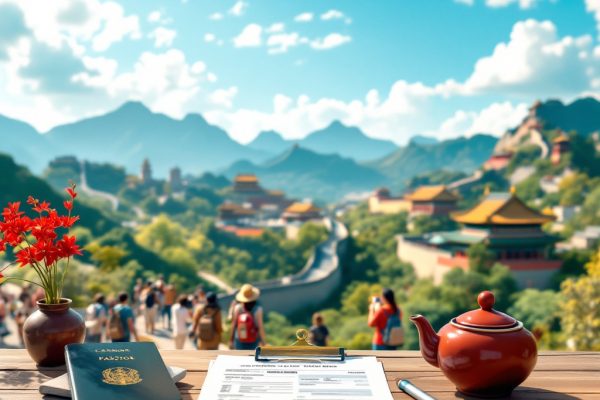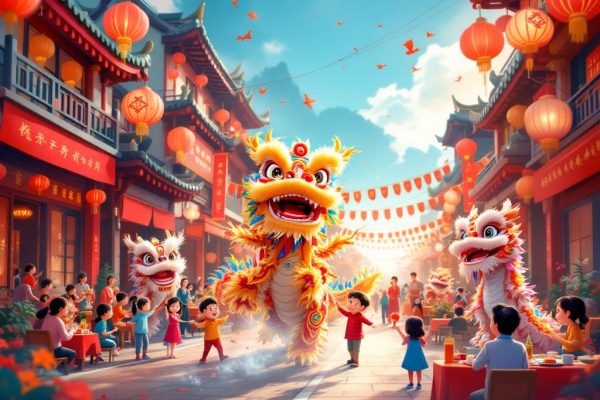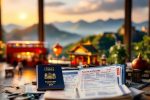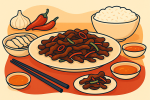When Is the Best Time to Travel to China? Month-by-Month Guide to Planning Your Trip
Dreaming of exploring China? Discover the best time to visit this diverse country, from the vibrant festivals of Harbin in January to the golden autumn hues of October. Whether you crave the thrill of winter landscapes or the bloom of spring flowers, this guide reveals the ideal time to experience China’s magic. Learn about regional climate variations, seasonal activities, and smart travel tips to avoid crowds and maximize your budget. Uncover your perfect China adventure now!
Important information
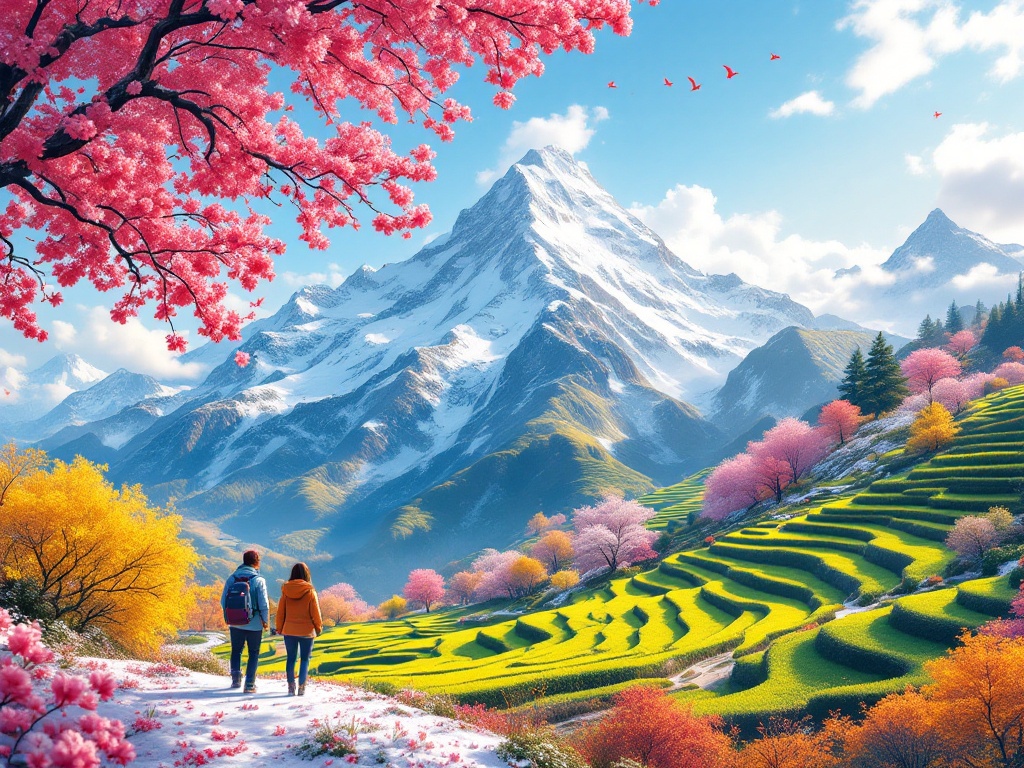
- Spring (April-May) and autumn (September-October) offer the best weather with fewer crowds.
- Summer (June-August) is hot and humid, especially in the south and east, coinciding with typhoon season along the coast.
- Winter (December-February) is cold, especially in the north, but offers unique experiences like ice festivals.
- November is a good time to visit for pleasant weather, fall foliage, and fewer crowds.
- Avoid peak seasons like National Day (October 1-7) and Labor Day (May 1-5) for a less crowded experience.
Best Time to Visit China: A Month-by-Month Guide
Planning a trip to China? Timing is crucial. For pleasant temperatures and fewer crowds, visit in spring (April-May) or autumn (September-October). Summer (June-August) can be hot and humid, especially in the south and east. Winter (December-February) offers unique experiences like ice festivals, but expect cold weather, particularly in the north. The best time to visit depends on your preferences.
January: Winter Landscapes and Festivals
Explore the diverse landscapes of China this January. From the icy north to the tropical south, find your perfect winter escape:
Northern China
Embrace the chill in Harbin, with temperatures between -8 and 2°C. This is the ideal time for skiing in the Changbai Mountains or witnessing the breathtaking beauty of frozen waterfalls.
Southern China
Enjoy milder weather in cities like Shanghai, where temperatures range from 2 to 8°C. Bask in the warmth of Sanya’s tropical beaches and immerse yourself in the vibrant local culture.
Alternative Destinations
Discover the unique winter charm of Dali and Lijiang, both offering comfortable temperatures perfect for exploration.
Cultural Experiences
Don’t miss the magical Harbin Ice Festival, a spectacular showcase of China’s rich January cultural offerings.
February: Golden Rapeseed Fields and Celebrations
Experience the magic of China in February. Celebrate the Lunar New Year amidst vibrant festivities and witness the breathtaking golden rapeseed blossoms in Luoping. While popular destinations may be bustling, this festive period offers a unique cultural immersion, allowing you to observe local traditions and events. For a quieter escape, explore the coastal beauty of Wanning. February is a rewarding time to discover China’s diverse landscapes and rich cultural heritage.
March: Mild Weather and Blooming Flowers
Experience the beauty of springtime in China during March. Southern regions bask in balmy temperatures, while the north retains a refreshing coolness. Flowers bloom in vibrant colors, creating breathtaking landscapes, especially in rural areas. Discover cities south of the Yangtze River, such as Guilin and Shanghai, where temperatures range from 10°C to 25°C (50°F to 77°F). Explore historical sites like the Forbidden City or the Terracotta Warriors in pleasant weather. Don’t miss unique March attractions, including the Peach Blossom Festival in Nyingchi and the vibrant rapeseed fields of Wuyuan.
April: Peony Festival and Outdoor Activities
Luoyang’s Peony Festival in April transforms the city into a vibrant spectacle, coinciding with ideal weather for exploration.
Yili bursts with blossoms, while Guilin offers a more intimate cultural experience due to smaller crowds amidst its stunning scenery. This creates a truly immersive journey.
May: Ideal for Exploring Guizhou’s Natural Wonders
May is the perfect time to visit Guizhou, offering beautiful weather ideal for outdoor exploration. Discover the province’s unique landscapes, including the amazing karst formations. The comfortable temperatures make any activity enjoyable, but pack layers as the weather can change quickly.
June: Shangri-La and Alpine Adventures
Escape to Shangri-La in Yunnan Province this June and discover vibrant alpine meadows and stunning lakes. Enjoy breathtaking scenery while hiking or horseback riding in the pleasant weather, perfect for experiencing the region’s unique culture and natural beauty.
Yunnan Province
Discover vibrant alpine meadows and stunning lakes. Experience the unique culture and natural beauty while hiking or horseback riding in pleasant weather.
Ili Kazakh Autonomous Prefecture
See vast grasslands erupt in a tapestry of wildflowers, transforming the landscape into a picturesque paradise in June.
July: Lush Greenery and Typhoon Precautions
July brings lush greenery and sparkling lakes to Daocheng Yading, creating a stunning vista. However, July also marks the start of typhoon season, lasting through September and mainly affecting China’s coastal areas.
August: Pleasant Weather for Outdoor Exploration
Experience China’s pleasant 20°C weather in August, perfect for outdoor activities. Explore destinations like Xinjiang and Mount Fanjing comfortably. Hiking is a popular choice, offering chances to see wildlife.
Remember to stay hydrated, especially in southern and central regions, where temperatures can reach 32°C. Coastal cities like Qingdao offer beautiful beaches. Metropolitan areas like Beijing and Shanghai provide various water activities for cooling down.
September: Red Beach and Autumn Beginnings
Witness the vibrant crimson hues of Panjin’s Red Beach in September, when the suaeda salsa transforms the landscape. Enjoy comfortable temperatures and fewer crowds compared to the summer months. Your trip might coincide with the Mid-Autumn Festival, offering a chance to experience traditional Chinese harvest celebrations.
Other September Destinations in China:
- Kanas: Explore breathtaking autumn foliage.
- Ulan Butong Grassland: Discover the beauty of the grasslands during the fall season.
Coastal Escape:
- Zhoushan: Enjoy pleasant weather and indulge in fresh seafood.
October: Golden Splendor and National Holidays
Experience China’s vibrant autumn hues this October. The Ejina Poplar Forest is especially magnificent, draped in gold. The first week of October coincides with China’s National Day holiday. This may lead to larger crowds and potential travel delays. However, the rest of the month offers ideal exploring weather. Mild temperatures and minimal rainfall create a comfortable environment with fewer tourists, enhancing your sightseeing adventures. Enjoy less crowded hiking trails and a more immersive experience of China’s fall beauty.
Advantages of Visiting in October (Except First Week)
- Mild temperatures, ideal for outdoor activities.
- Minimal rainfall, ensuring comfortable sightseeing.
- Fewer tourists, allowing for a more immersive experience.
- Less crowded hiking trails.
Considerations for the First Week of October
China’s National Day holiday may result in:
- Larger crowds.
- Potential travel delays.
November: Autumn Foliage and Crisp Air
Experience the serene beauty of a Chinese autumn, especially in November when the foliage peaks in the north and central regions. The crisp air and thinner crowds create a peaceful atmosphere for exploration. The Fragrant Hills near Beijing are a prime example, becoming ablaze with color during this time.
December: Ice Festivals and Winter Solitude
Escape the hustle and bustle this December with a tranquil winter retreat. China’s renowned ice festivals offer a unique experience, particularly in Harbin, home to the magical Ice and Snow World. Imagine a wonderland of intricate ice sculptures and breathtaking snow carvings. For a milder December adventure, explore the historical sites of Southern China, enjoying a more intimate experience with fewer crowds. Consider these two distinct December travel experiences in China:
Harbin Ice and Snow World
Experience the magic of the Harbin International Ice and Snow Sculpture Festival, a winter wonderland featuring intricate ice sculptures, breathtaking snow carvings, and illuminated ice palaces. This unique festival attracts visitors from around the globe.
Southern China Exploration
Discover the historical sites and cultural richness of Southern China. Enjoy a more intimate travel experience with fewer crowds and milder December weather. Explore ancient temples, bustling markets, and picturesque landscapes.
Understanding China’s Climate and Weather Patterns
China’s diverse landscape creates a wide range of climates. The north experiences frigid, dry winters and hot, humid summers. The south, a subtropical region, enjoys milder winters and similarly hot, humid summers. Western China, encompassing the high-altitude Tibetan Plateau, endures harsh, cold winters and brief, cool summers. The east has a monsoon climate with distinct wet and dry seasons, and its coastal areas are vulnerable to typhoons, mainly between July and September. Mountainous areas, including the Himalayas and Tibetan Plateau, feature alpine climates with year-round snow. Understanding these regional variations is essential for planning any trip to China.
North
Frigid, dry winters and hot, humid summers.
South
Milder winters and hot, humid summers. Subtropical region.
West
Harsh, cold winters and brief, cool summers. High-altitude Tibetan Plateau.
East
Distinct wet and dry seasons (monsoon climate). Coastal areas vulnerable to typhoons, primarily between July and September.
Mountains
Alpine climates with year-round snow. Includes Himalayas and Tibetan Plateau.
Regional Differences: North, South, East, and West
China’s vast landscape shapes its diverse regional climates. The north experiences frigid winters and scorching summers. The subtropical south has mild winters and hot, humid summers fueled by monsoons. East China enjoys four distinct, temperate seasons. The west presents a dramatic range, from scorching deserts to high-altitude plateaus, showcasing China’s diverse meteorology.
Coastal Regions: Weather and Typhoon Season
China’s coastal weather is significantly affected by the ocean, resulting in diverse conditions. Typhoons are prevalent from July to September. Coastal cities like Shanghai and Guangzhou become especially attractive outside typhoon season. Enjoy pleasant weather during spring, late summer, autumn, and early winter. Monsoon rains typically occur in late spring and early summer, so consider this when planning your trip.
Mountainous Areas: Ideal Times for Hiking and Trekking
The ideal time for hiking and trekking in China’s mountains is June through August, when the weather creates favorable conditions for exploration.
Seasonal Activities and Festivals in China
Spring Festivals:
- Early April: Tomb-Sweeping Day, a time to honor ancestors and enjoy the outdoors.
- June: Dragon Boat Festival, featuring exciting races and delicious *zongzi* (rice dumplings wrapped in bamboo leaves).
Summer Experiences:
- Lusheng Festival: Experience the Miao people’s vibrant music, dances, and traditional attire.
- Mid-April: Dai New Year (Water Splashing Festival), a joyous celebration of good luck with playful water splashing.
Autumn Events:
- September/October: Mid-Autumn Festival, a time for family reunions and mooncakes.
- Autumn foliage: Capture stunning photos of the colorful landscapes in places like Jiuzhaigou and the Red Beach.
Winter Adventures:
- Starting late December: Harbin Ice Festival, showcasing magnificent ice sculptures and winter activities.
- December: Enjoy festive shopping and entertainment at Christmas markets in many cities.
Spring Festivals: Tomb-Sweeping and Dragon Boat
In early April, families gather for Tomb-Sweeping Day (Qingming Festival) to honor their ancestors. This involves cleaning and visiting their tombs. In June, the Dragon Boat Festival takes place. It is a celebration of the poet Qu Yuan, featuring exciting dragon boat races and the tradition of eating zongzi, a glutinous rice dish.
Summer Events: Lusheng and Dai New Year
In Guizhou, the Miao people’s Lusheng Festival showcases their traditional free-reed instrument, the lusheng. Meanwhile, mid-April marks the Dai people’s New Year, a vibrant celebration also known as the Water Splashing Festival. This unique tradition involves splashing water, symbolizing good luck and prosperity for the coming year.
Autumn Celebrations: Mid-Autumn and Photography Opportunities
The Mid-Autumn Festival, falling in September or early October, is a photographer’s dream. Imagine vibrant lanterns, delicious mooncakes, and heartwarming family gatherings: it’s a feast for the eyes and a chance to capture the cultural spirit. October further enhances the beauty with pleasant weather and stunning autumn leaves, transforming national parks into picturesque wonderlands. However, the festival’s charm can be found anywhere, from the warm glow of lanterns against the night sky to the intricate details of a mooncake close-up.
Winter Highlights: Harbin Ice Festival and Christmas Markets
Harbin’s breathtaking ice sculptures draw crowds to its annual Ice and Snow Festival from across the globe. Meanwhile, China’s Christmas markets offer festive fun and unique gifts, alongside seasonal treats and cheerful decorations. They create a vibrant atmosphere blending international celebrations with local traditions.
Travel Tips for Planning Your China Trip
Planning your trip to China? Consider these factors when packing:
Season and Region
China’s diverse climate means packing will vary depending on the region and season. Spring and autumn generally offer the most pleasant temperatures, ideal for comfortable sightseeing. Summers can be hot and humid, especially in the south, so pack accordingly. Northern winters are harsh, requiring warm clothing. Consider the specific region you’re visiting when choosing your wardrobe.
Travel Dates
Peak seasons, such as Labor Day (May 1-5) and National Day (October 1-7), attract large crowds. If you prefer a less crowded experience, consider traveling during the shoulder seasons. May offers pleasant weather and fewer tourists, perfect for exploring natural wonders like those in Guizhou. November is another excellent option, with crisp air and stunning scenery ideal for visiting historical sites. Traveling during the shoulder seasons can also be more budget-friendly.
Avoiding Tourist Crowds and Busy Holidays
Traveling to China? Consider these tips for a smoother trip:
Best Time to Visit
For pleasant weather and fewer crowds, visit China in November.
Peak Seasons to Avoid
- National Day (October 1-7): Domestic tourism surges during this period, leading to packed attractions and transportation.
- Labor Day (May 1-5): Similar to National Day, expect large crowds and potential travel disruptions.
Weather Considerations
Be mindful of Southern China’s rainy season in June, which can disrupt outdoor plans.
Weather Considerations and Packing Guide
Packing for your China trip requires a strategic approach to layering, accommodating the country’s varied climate. Northern China presents freezing winters and scorching summers. The south offers milder winters and hot, humid summers. Western China showcases a dry, continental climate. Eastern China is characterized by monsoons. Pack a waterproof jacket, especially for the monsoon season (May to September) impacting southern and eastern China. Comfortable walking shoes are essential for navigating China’s dynamic urban areas and breathtaking scenery.
Budget-Friendly Travel and Off-Peak Recommendations
Traveling during the shoulder seasons (spring and autumn) offers a more affordable and enjoyable experience. These periods, typically April-May and September-October, provide pleasant weather, fewer crowds, and lower prices in popular destinations like Beijing or Shanghai. The comfortable temperatures are ideal for sightseeing. Alternatively, winter (excluding major holidays) is another excellent option for budget travelers, offering unique landscapes and festivals. However, pre-trip research is essential. For example, visiting Jiuzhaigou Valley mid-week avoids weekend crowds. By identifying the least crowded times, you’ll save money and enjoy a more relaxed trip.

